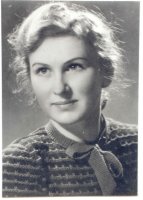
Barbara Gancarczyk-Piotrowska,
born on the 18th of October 1923 in Warsaw
the nurse of the Home Army
pseud. "Pajak" (=spider)
the 2nd platoon of the assault company
Scouts' battalion of the Home Army "Wigry"
Insurgent accounts of the witnesses
War Reminiscences of the nurse of the Scouts' battalion of the Home Army "Wigry" Barbara Gancarczyk-Piotrowska pseud. "Pajak" (=Spider)
The return
We lived to see the liberation in Nowy Targ. On the following day, 30 January 1945, we began our journey to Warsaw. Two women joined us. One of them was heavily pregnant. We loaded all our stuff and large baggage of our companions on a big sledge, which we pulled along.
We reached Krakow after four days of going on foot, on 2nd February. It was thaw. Snow banks on the road changed into a muddy slush. We had to take our baggage off the sledge and shoulder it.
The military cars which passed us on the road spattered us with mud from head to foot. In our hands, we had wooden walking sticks to lean on, and on our backs bundles secured on our necks. In Krakow people stopped us on the streets, asking which camp we were coming from.
While we were in Nowy Targ I learned that my aunt - Helena Urbanska - together with her daughter Joasia was taken from Krakow to Warsaw with the hospital. I knew her address. It is where we headed.
In the first moment, the aunt, seeing in front of her house 4 women armed with walking sticks, with bundles on their backs, incredibly muddy, asking for lodgings, was dumb with amazement.
However, as soon as she recognized me, she was moved and glad that I had survived the uprising. Even though there were already five people sleeping on the floor, the aunt found some place for the four of us on a makeshift beds on the floor.
We were told that the trains do not go yet from Krakow to Warsaw, but apparently they went from Rzeszow. We went to the city's tollgate and managed to hitch a free ride - a military Soviet car which went to Rzeszow. The passengers had to pay the driver before the departure, giving him vodka and cigarettes (money had no value then) and after about 20 kilometers he stopped, claiming that the car had broken down.
He ordered everyone to get out and push the car so that it would start. The car started indeed and speeded forward, leaving naive passengers in the middle of the road. One had to hitch another free ride.
In Rzeszow we learned that there is a train to Lublin, and from Lublin to Warsaw, but only once a week and nobody knows when it comes. In Rzeszow we waited three days long in front of the Province building, waiting to hitch a free ride by car.
We hitched a free ride in form of a fire engine which was going to Lublin, but in a round-about way. We decided immediately. We are going! Two of our companions left Rzeszow 2 days earlier, but there was not enough place for us.
Along the road, we stopped for a night in Janow. Generally, when we wanted to find lodgings, we went to the police station and we were assigned some place. However, there was a middle of the night in Janow. In this case, we stayed overnight by some carpenter in the storehouse full of coffins.
I had family in Lublin, but I did not know the address. I knew only their surname. We reached Lublin late evening and we did not know what to do. It was cold, and we had our stuff packed on the sledge. We ended up in a parsonage of some evangelical church. We asked for permission to leave the sledge with our stuff, and went in search of the family. We arranged that in case of not finding our family we would be allowed to stay overnight on the chairs in the parsonage. They agreed to it.
I started to search for my distant relatives. Luckily, before the war they had a well-known sweet shop and because we knew their name, we finally reached them. We stayed overnight there.
Now all we had to do was to reach Warsaw. Traditionally, there was no train to Warsaw. We went to the city's tollgate and waited to hitch a free ride. A large military transport of Polish soldiers came. These were trucks, most of them open carriages, but some had canvas covers. We asked if they were going to Warsaw. The soldiers were very friendly.
"Yes, to Warsaw, come with us."
The carriage was roofed and there were benches inside. A lot of young boys from Vilnius, very nice ones. One could discover where they were from by how they spoke. We told them that we had been in a camp and asked where they were from. Time on the road passed very quickly.
Unfortunately, somewhere near Garwolin the entire transport was stopped and each truck was checked whether they were any civilians on it. Soviet soldiers controlled the trucks. They threw away every person travelling illegally, leaving them in the open, in spite of darkness and cold. They approached our track. The boys from Vilnius seated us down next to the driver's cab and covered us from view. The gendarmes asked whether there were any civilians there. The answer was negative. They believed it and the convoy drove away.
In this way we came to Warsaw, to Szembeka Square. "Janka" lived near the square, so we got off here, having thanked for the ride. We reached her home. Her parents were already home. It was 10 February 1945. The same evening, I went from Grochow to Saska Kepa, to my parents. The Gruszczynskis wanted to stop me, but I wanted to see what happened in my home as soon as possible.
I went through Washington Avenue, and I remember that there was not a living soul there. On Grochowska Street, some Soviet soldiers loitered around. I was a bit scared, but there was no one on Washington Avenue. It turned out that the house still stands and that my parents and sister are home.
I learned what happened to them during the uprising. Before the outbreak of the uprising, my younger sister Elzbieta was notified that she had to turn up on Grochowska Street in the opening of Miedzynarodowa Street. There was some kind of dressing station there. She went with her first aid kit.
She spent the night in a group of girls and boys. On the following day they were told that unfortunately they had to disperse to their homes. So, sister came back to the parents. She told me that she was going with two friends through Zieleniecka Street. They went with their hearts in their throats, since they met some German soldiers who pretended not to see them when they saw them coming from the other side of the street. They got happily home.
Later on, there was a dressing station on Saska Kepa, organized by her guide leader. According to the rules of the underground, sister knew only five people. Someone alerted her that there were wounded who had taken part in the attack on Poniatowski Bridge. The wounded were on Obroncow Street, somewhere near Dabrowiecka Street. Sister went there, found a dressing station and some wounded. She took care of them, but she went back home for the night.
Later the dressing station was closed down and after two weeks sister permanently returned home. People who lived on Saska Kepa next to Vistula were displaced by the Germans. It was frontline area. Part of these people went to camps, even concentration camps. Among them there were our acquaintances. Sister was in the hiding with parents. The Germans constantly organized roundups.
At the beginning, all men had to turn up on Washington Roundabout. My father also went there. There was an announcement that men and young women had to present themselves there under the threat of punishment. Men were taken away to Germany. Many of them did not return. Others, like my parents and sister, were in hiding. My family found shelter by their acquaintances on Elsterska Street. They barricaded themselves in a cellar with coal, there were also other hiding places. They were in hiding there until September, until the coming of Russian troops.
My mum was even in our demolished house, in the cellar. She said that from the cellar window she had seen some Germans passing by. They were looking at our house, wondering whether to go inside. At last, one waved his hand and they went on.
The ones who were in hiding in the ruins and other places, survived. Most of these who followed the summons of the Germans, did not return. When the Russians came, Saska Kepa was heavily shelled. A lot of people perished, among others our neighbors. In these circumstances, my parents left for the East, for a place which we used to frequent on holidays before the war. There were special military transports organized for the runaways. Cars drove up, took the people and placed them on the line of Otwock.
When the Germans left Warsaw, my parents returned to their demolished home. They knew nothing about my lot. They knew only about my concentration point in the Old Town. They were not sure whether they would ever see me again.
As soon as on 11 February 1945, on the following day after our return to Warsaw, I and "Janka" were in the Old Town. The hospital on Dluga Street - burnt down. The corpses of the shot down people, partially burnt down - on the courtyard of the building, on the ground floor, in the cellars. The first floor, where our friends from "Wigry" lay, was filled with a layer of rubble one meter high.
In the gate on Kilinskiego Street 1 - partially burnt corpses of the boys from "Gustaw" who remained there. There is no way to identify anyone. So perhaps no one was saved. If... it was the only one, the boy from "Gustaw," slightly injured in his leg, who was lying in the kitchenette on the ground floor of the building on Kilinskiego Street 3. We carried him to Dluga Street 7 to the gate then... "Janka" claims that she had seen him in the camp in Pruszkow. But was it really him? We would like to have some certainty that at least only one human life was saved, it would be for us a reward for all our toil which may not have been in vain.
Later it turned out that from among the wounded, who stayed, only "Ikar" who was Wisia's sweetheart, survived. From among the remaining four from "Wigry" no one survived, all of them perished on the first floor of the hospital on Dluga Street. Nobody from "Wigry" survived in the cellars, either.
From the group of 12 or 15 boys from "Gustaw" from Kilinskiego Street, whom we tried to save together with "Janka" only one named Wegner survived, who was lying on the ground floor. Three of them had been lying on the ground floor, but only he survived.
He survived because he asked a nurse to carry him from the hospital gate on Dluga Street 7 to its interior. When the Germans went to the hospital and ordered the hospital staff and the slightly injured to leave, he went with them. A nurse and a man held him under his arms and led him. These people took turns to carry him many times along the road and in this way they reached Wola, and then Pruszkow.
Father Rostworowski sent to me Mrs. Bielanska, the mother of "Firlej" who had been lying next to Wegner. She had a photograph of her son with her. Of course I recognized him. He was very handsome, he had a very pretty, delicate face. I told his mother that her son had been lying on Kilinskiego Street 3 and was carried by us to the hospital on Dluga Street 7, where he was unfortunately murdered. "Janka" claims that yet another boy from among the ones on Kilinskiego Street 3 survived, but he died in hospital very soon afterwards.
The first funerals were in spring 1945. They began to prepare the cemeteries later. In the spring of 1945, we exhumed "Stasiuk," "Klecha" and "Robert" from Dluga Street, with the help of our friends "Zbych" and "Nietyksza." They perished on the same place where we left them. Metal fittings was all that remained of the stretchers, and between them there were the charred corpses. On "Stasiuk" we found a whistle, a scorched identity card, which mouldered away in our hands, as well as a tiny silver heart, a gift from his fiancée. Klecha's sister recognized Tadzio by the buttons of his clothes. There were also some things found on "Robert." They all have their own graves on the Military Cemetery. They do not lie in nameless, mass graves. It was all what we could do for them.
In the spring of 1945, when it was getting warmer, human remains were collected from streets, cellars, houses and buried in a nameless mass grave in Krasinski Garden. The corpses from the courtyard cemeteries and squares were also removed there.
This exhumation was organized by Polish Red Cross. It was conducted in a rather careless way. For example, on Kilinskiego Street 1/3 there was a large cemetery in the courtyard. We also buried our dead there. Usually in some boxes made of planks nailed together, inside of which there were bottles with names and these same names were on the crosses.
But there was no trace of it in Polish Red Cross. Simply, the corpses were taken from the cemetery to a nameless, mass grave in Krasinski Garden in spite of the fact that they had their name tags.
Not until 1947 were the corpses exhumed from Krasinski Garden, mainly to Powazki Military Cemetery, where they were cemetery sections assigned for individual units. I got a letter from the City Funeral Parlour, saying that on 15 April 1947 the exhumation of corpses from Krasinski Garden would start.
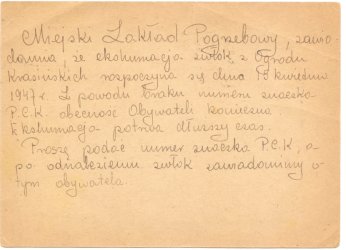 |
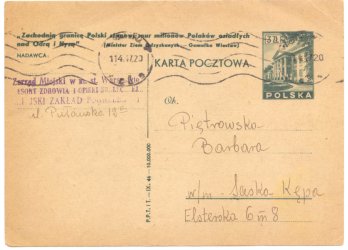 |
the letter from the City Funeral Parlour concerning the exhumation
Families looking for their close ones came to Krasinski Garden. We from "Wigry" also were on duty there, trying to identify the corpses, even though it was practically impossible. We stood there for several hours, one can imagine in what condition.
The burials of the Home Army soldiers were organized by lieu. "Radoslaw" and Ms. Romocka. We searched for our dead and buried them according to a list we had.
It happened that we put an identified corpse aside, to carry it to the cemetery on a specially prepared horsewaggons later on. However in the afternoon it was gone, since it was taken to the People's Army cemetery section. And therefore the cemetery section of the People's Army grew to be the biggest one; however it was known that this formation, since it was not a numerous one, did not play any significant role during the Warsaw Uprising. In contrast, the place for the Home Army's soldiers on the Military Cemetery was very scantily assigned.
The search for the corpses ended in 1947. Most of the people, who died in the Old Town, was buried in the cemetery in Wola. It was a conscious move on the part of the government, in order to mix the dead bodies.
I suppose that the burnt corpses from Dluga Street 7, together with the rubble were taken to the mound on Bartycka Street, or maybe to 10th-Anniversary Stadium during the rubble clearance. On Dluga Street 7, the rest of the roof, two ceilings collapsed. When I came there with Janka in 1945, the rubble reached the windowsill.
First the rubble was carried away from the Old Town, and then the reconstruction began. The buildings were probably built on the old foundation. In practice, no whole house survived.
After my return to Warsaw I started my studies, but not immediately. The Architecture Faculty started its work no sooner than 1946. I remember that there was a Ball of the Young Architecture organized in the Faculty. We, who returned, my friends and my future husband - Maria-Tadeusz Gancarczyk, began our studies by clearing the Architecture Faculty of the ruble. My husband worked on the roof, and I carried out the rubble. Measurements were taken. Later I got married and had a child. My studies were prolonged. I graduated as late as in 1952.
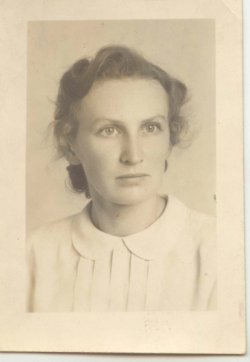
Barbara Gancarczyk-Piotrowska in 1951
I did not have any military rank during the uprising. I was a patrol nurse, as it was called in those times. Later it all got mixed up. There were no typical 5-people patrols. There were two of us or one there.
We were given military ranks after the war and as late as in 1990s. During the uprising I was decorated with the Cross of Valor. I found the decoration motion for our group of nurses in the Encyclopedia of the Warsaw Uprising.
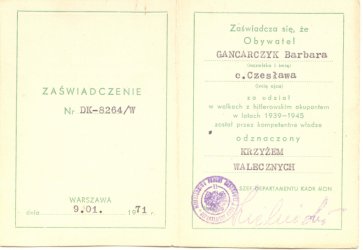
the proof certificate of the Cross of Valour for Barbara Gancarczyk
After the uprising I got the War Order of Virtuti Militari. The award committee of Virtuti Military worked in London during the war. As late as in 1990 it was moved to Poland.
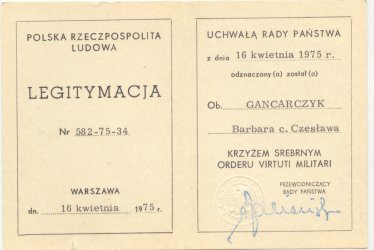
the proof certificate of the Virtuti Militari Cross for Barbara Gancarczyk
In 1985 "Gustaw-Harnas" Organization awarded me with a honorary decoration with the annotation: "We remember the selfless help given to the wounded soldiers left in the Old Town..."
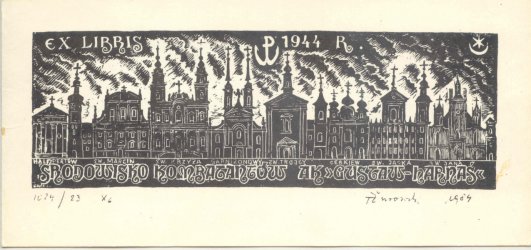

the proof certificate of "Gustaw-Harnas" Organisation
From among various distinctions I value highly also the Digno Laude medal (to one worthy of glory), which I was awarded in 2005 by Warsaw Medical Society for my participation in the Insurgent Sanitary Service.
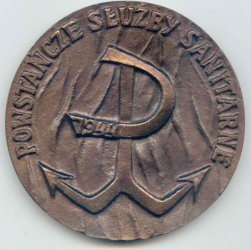 |
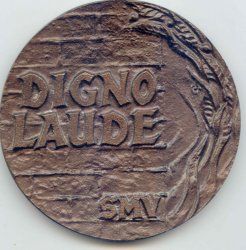 |
Digno Laude medal (to one worthy of glory)
It is difficult to pass unambiguous judgment on the Uprising. Now we reach documents which we did not know then. The answer to the question whether the decision about the outbreak of the uprising was right or wrong I leave to the historians. The reasons for this and not other decision were diverse. It is also hard to tell what were the advantages and what were the losses. For me, the greatest loss was the deaths of so many people, precious people. Directly after the uprising I was glad that it had come to its end, most of all because there would be no fatalities more. Though there were some fatalities also later on.
As far as my friends are concerned, we talked about it, before and after the outbreak of the uprising. There were alerts and initial orders. Our predictions were rather sceptical. Personally, I was afraid that we would not manage to do it.
Barbara Gancarczyk-Piotrowska
prepared by Maciej Janaszek-Seydlitz
translated by Katarzyna Wiktoria Klag
Copyright © 2013 Maciej Janaszek-Seydlitz. All rights reserved.